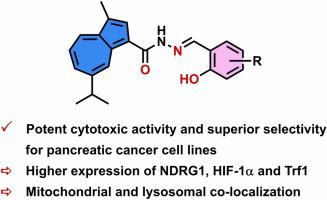Biomedicine & Pharmacotherapy ( IF 6.9 ) Pub Date : 2022-09-23 , DOI: 10.1016/j.biopha.2022.113736 Tereza Brogyányi 1 , Robert Kaplánek 2 , Zdeněk Kejík 2 , Božena Hosnedlová 2 , Veronika Antonyová 2 , Nikita Abramenko 3 , Kateřina Veselá 2 , Pavel Martásek 4 , Martin Vokurka 5 , Des R Richardson 6 , Milan Jakubek 2

|
Dysregulation of iron homeostasis is one of the important processes in the development of many oncological diseases, such as pancreatic cancer. Targeting it with specific agents, such as an iron chelator, are promising therapeutic methods. In this study, we tested the cytotoxicity of novel azulene hydrazide-hydrazone-based chelators against pancreatic cancer cell lines (MIA PaCa-2, PANC-1, AsPC-1). All prepared chelators (compounds 4-6) showed strong cytotoxicity against pancreatic cancer cell lines and high selectivity for cancer cell lines compared to the healthy line. Their cytotoxicity is lower than thiosemicarbazone-based chelators Dp44mT and DpC, but significantly higher than hydroxamic acid-based chelator DFO. The chelator tested showed mitochondrial and lysosomal co-localization and its mechanism of action was based on the induction of hypoxia-inducible factor-1-alpha (HIF-1α), N-myc downstream-regulated gene-1 (NDRG1) and transferrin receptor 1 (TfR1). This strongly implies that the cytotoxic effect of tested chelators could be associated with mitophagy induction. Lipinski's rule of five analyses was performed to determine whether the prepared compounds had properties ensuring their bioavailability. In addition, the drug-likeness and drug-score were calculated and discussed.
中文翻译:

用于选择性靶向胰腺癌细胞的甘菊酰肼-腙
铁稳态失调是许多肿瘤疾病(例如胰腺癌)发展的重要过程之一。使用特定药物(例如铁螯合剂)靶向它是有前途的治疗方法。在这项研究中,我们测试了新型薁酰肼-腙螯合剂对胰腺癌细胞系(MIA PaCa-2、PANC-1、AsPC-1)的细胞毒性。与健康细胞系相比,所有制备的螯合剂(化合物4-6 )均表现出针对胰腺癌细胞系的强细胞毒性和对癌细胞系的高选择性。它们的细胞毒性低于缩氨基硫脲基螯合剂Dp44mT和DpC,但显着高于异羟肟酸基螯合剂DFO。测试的螯合剂显示线粒体和溶酶体共定位,其作用机制基于缺氧诱导因子-1-α (HIF-1α)、N-myc 下游调节基因-1 (NDRG1) 和转铁蛋白受体的诱导1 (TfR1)。这强烈暗示所测试的螯合剂的细胞毒性作用可能与线粒体自噬诱导有关。进行利宾斯基五分析法则以确定所制备的化合物是否具有确保其生物利用度的特性。此外,还计算并讨论了药物相似度和药物评分。











































 京公网安备 11010802027423号
京公网安备 11010802027423号